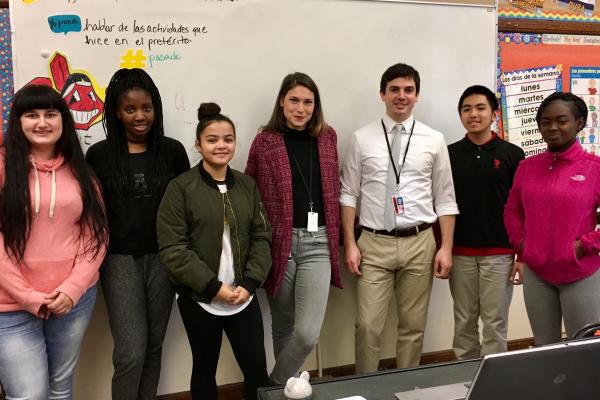Center for Slavic and East European Studies Partners with Local K-12 School to Teach Russian Language and Culture Course

By Kathryn Metz, Outreach Coordinator at the Center for Slavic and East European Studies
In 2016, The Ohio State University’s (OSU) Center for Slavic and East European Studies (CSEES) launched a new program teaching a Russian language and Eastern European culture course at Columbus North International School, a school in Columbus, Ohio that teaches grades 7-12. Working with the Department for Slavic and East European Languages and Cultures (DSEELC), the courses are taught by OSU PhD students and CSEES’ Outreach Coordinator.
Columbus North International School is a Columbus City School that focuses on creating a global education by emphasizing language, culture and history at the secondary school level. CNIS has a robust world language and culture department, offering students the opportunity to study seven foreign languages. With a student body containing over 45 countries of origin and encompassing 20 home languages, the school is culturally and ethnically diverse. Close to 63% of the students are African American, 24% are Latino/a, and 100% are considered economically disadvantaged by State of Ohio standards. Since many of the students come from African and Latin American countries, CNIS Principal Kenton Lee saw a need to educate his students about Eastern Europe and acquaint them with a less familiar region of the world.
CSEES and DSEELC have worked with CNIS since 2012 to enhance their Russian language offerings. CNIS had a growing Russian program and competed in OSU’s annual K-12 Russian Olympiada. When the CNIS’ Russian teacher retired in 2016, Lee invited CSEES and DSEELC to continue the school’s Russian program by designing a course and contributing teachers. The partnership is made possible by DSEELC’s contribution of pedagogical resources and teachers, CSEES’ Title VI grant funds from the International and Foreign Language Education division of the federal Department of Education, and CNIS’ dedication to provide quality language and cultural instruction to their students.
Greg Ormiston, a graduate student in DSEELC, is teaching the Russian language section during the fall semester; in the spring Ray Alston, also a graduate student in DSEELC, will continue teaching the course. Kathryn Metz, outreach coordinator at CSEES, is supplementing the language section of the class by teaching two lessons on Eastern European culture each week. There are seven students in the class, ranging from 9th to the 12th grade. Two of them previously studied Russian at CNIS, while the others are new to the language and culture. The students are earning elective credit for Russian and Eastern European Cultures through the Ohio Department of Education's Credit Flexibility Option.
“The CNIS students have enthusiastically embraced the challenge of learning Russian and they are quick learners,” said Ormiston. “Though the majority of the class had not studied the language before the beginning of the school year, they can already introduce themselves, talk about their families, nationalities, the languages they know and the clothes they wear. Their reading and writing skills are coming along well, and their vocabulary is growing every week. In class we have had a lot of fun learning the language through Russian culture as well (songs, cartoons, videos). In the coming weeks we are hoping to take a field trip to Ohio State to see what a Russian class is like at the university level, and to interact with some other Russian speakers.”
In the culture part of the class, Metz is teaching students the history, geography, religion and customs of Eastern Europe, the Caucasus and Central Asia. The students are fascinated to learn about this part of the world and are diligently undertaking the study of the rich history and traditions of the region. Thus far they have learned about the Russian, Ottoman and Austro-Hungarian Empires, and the Russian Revolution and Communism in the Soviet Union.
According to the students, the class is enriching and interesting.
“I like this class because it teaches us about different cultures’ histories that normal world history classes don’t teach. It helps me understand the world a little better and makes me feel smarter,” said Stephanie, a 10th grade student.
Ceara, a 12th grade student, agreed. “There is a lot of history that made Russia and Eastern Europe what it is today and I’m glad I have the opportunity to be in a class like this.”
Students from the Columbus North International School visited Ohio State in November to tour the campus, visit a Russian class and meet with students and faculty. The opportunity allowed the students to get acquainted with Ohio State and inspired them to start thinking about applying to college. In early March the students will have the opportunity to showcase their language skills at the 2017 high school Russian Olympiada, hosted by DSEELC and CSEES at Ohio State. In addition to visiting Ohio State’s campus, CNIS students meet with OSU graduate students who visit the culture section of the class to present lectures. Justin Ciucevich, a CSEES MA student, visited the class for Halloween and gave a lecture on Vlad the Impaler and the history of Dracula in Romania. Such activities not only introduce the CNIS students to different perspectives, but give graduate students the opportunity to present their research in a setting outside of the academy, giving them opportunities to learn how to appropriately cater information to reach different audiences.
The Russian language and Eastern European culture course will be offered again in the 2017-2018 academic year at CNIS, allowing this partnership to flourish and to continue the education of secondary school students in Russian language and Eastern European culture.
